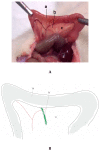Murine Models of Acute Pancreatitis: A Critical Appraisal of Clinical Relevance
- PMID: 31181644
- PMCID: PMC6600324
- DOI: 10.3390/ijms20112794
Murine Models of Acute Pancreatitis: A Critical Appraisal of Clinical Relevance
Abstract
Acute pancreatitis (AP) is a severe disease associated with high morbidity and mortality. Clinical studies can provide some data concerning the etiology, pathophysiology, and outcomes of this disease. However, the study of early events and new targeted therapies cannot be performed on humans due to ethical reasons. Experimental murine models can be used in the understanding of the pancreatic inflammation, because they are able to closely mimic the main features of human AP, namely their histologic glandular changes and distant organ failure. These models continue to be important research tools for the reproduction of the etiological, environmental, and genetic factors associated with the pathogenesis of this inflammatory pathology and the exploration of novel therapeutic options. This review provides an overview of several murine models of AP. Furthermore, special focus is made on the most frequently carried out models, the protocols used, and their advantages and limitations. Finally, examples are provided of the use of these models to improve knowledge of the mechanisms involved in the pathogenesis, identify new biomarkers of severity, and develop new targeted therapies.
Keywords: acute pancreatitis; animal models; biomarkers; experimental models; inflammation; murine.
Conflict of interest statement
The authors declare no conflict of interest.
Figures




References
-
- Garg S.K., Sarvepalli S., Campbell J.P., Obaitan I., Singh D., Bazerbachi F., Singh R., Sanaka M.R. Incidence, Admission Rates, and Predictors, and Economic Burden of Adult Emergency Visits for Acute Pancreatitis. J. Clin. Gastroenterol. 2019;53:220–225. doi: 10.1097/MCG.0000000000001030. - DOI - PubMed
-
- Jha R.K., Ma Q., Sha H., Palikhe M. Acute pancreatitis: A literature review. Med Sci. Monit. 2009;15:RA147–RA156. - PubMed
-
- Ikeura T., Horibe M., Sanui M., Sasaki M., Kuwagata Y., Nishi K., Kariya S., Sawano H., Goto T., Hamada T. Validation of the efficacy of the prognostic factor score in the Japanese severity criteria for severe acute pancreatitis: A large multicenter study. United Eur. Gastroenterol. J. 2017;5:389–397. doi: 10.1177/2050640616670566. - DOI - PMC - PubMed
Publication types
MeSH terms
Substances
LinkOut - more resources
Full Text Sources

